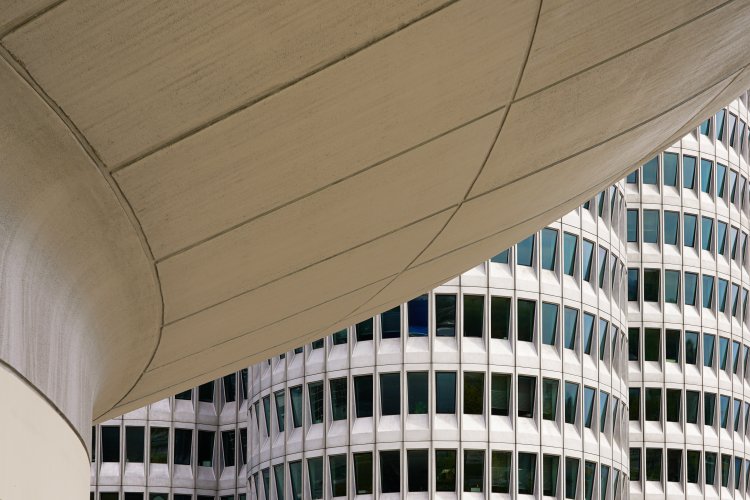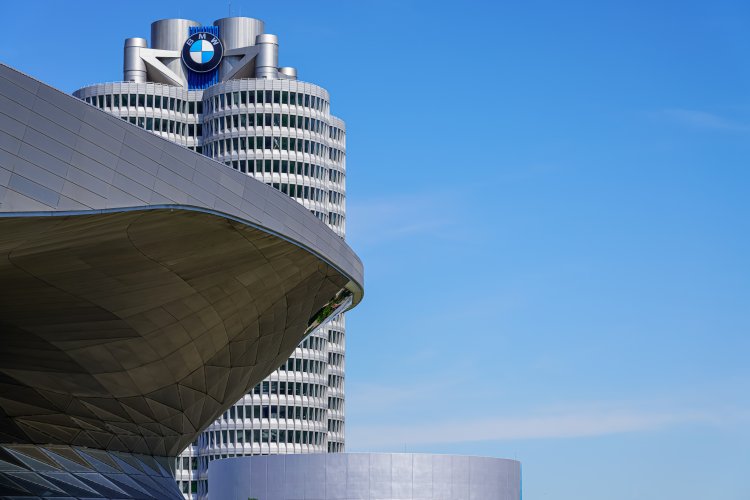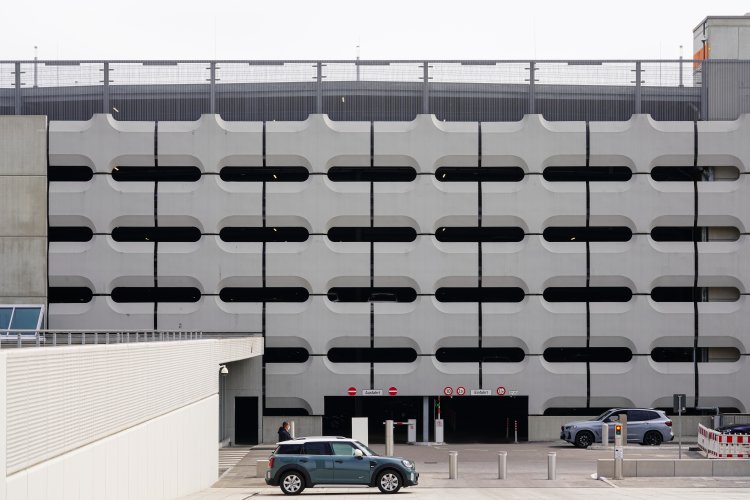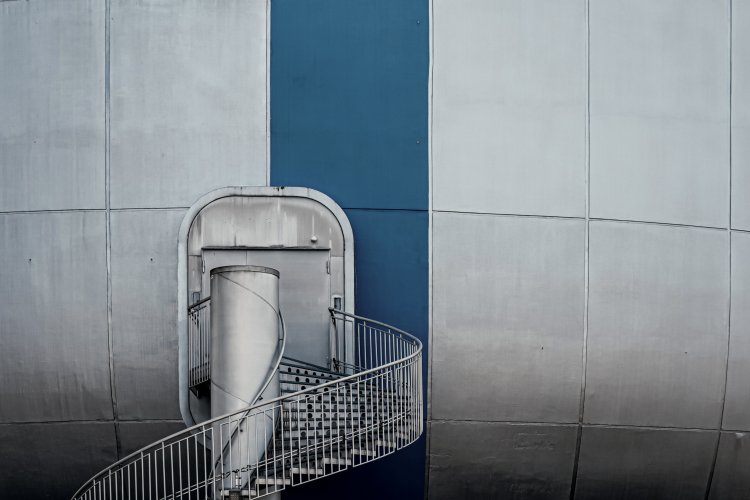Perfection in Blue-White - An extraordinary Architectural Ensemble in Munich written by Prof.Dr. Rainer Funke
The BMW ensemble in Munich is an impressive work of futuristic architecture. It includes the BMW Tower, BMW Welt, BMW Museum, BMW Group Parking Garage and the TRIAS Bridge. BMW Welt is the most visited tourist attraction in Bavaria. In October 2015, eight years after opening, BMW Welt welcomed its 20 millionth visitor.
Written by Prof. Dr. Rainer Funke. Photographs by Michael Nguyen
Going towards Munich city center from the north via the motorway, you will pass Bavarian Motor Works (BMW) Headquarters with its striking, iconic four-cylinder office tower and the amphitheatrical "bowl" of the BMW Museum. Just then unfolds the gleaming, sweeping BMW World itself right before your eyes. Like a campanile tower in Italy, the buildings emanate a greeting, a bold statement to visitors: Munich is BMW City, and Munich is modern. Yes, one will be overwhelmed and admire its magnificence when physically there. But this imposing grandeur is not shown in the photos of Michael Nguyen, but the details of the exterior, the skin of a building landscape that he explores. He takes us very close and entangles us in the diversity of forms. Sections of the whole appear in a way that the unusual view almost paradoxically creates an extraordinary, surprising closeness as well as joy in the distinctive shape of the elemental.
When the BMW logo appears distorted or displaced in the reflections of glass façade and starts to flow like Dali's clocks, but still we recognize it effortlessly, we realize the indestructible strength of this classic trademark. (#3335, #3323)
Appearently, the only color in these pictures is Blue, in contrast to the white and grey tones. Very Bavarian, very BMW. And very cool, as cool as the grey of the smooth, pure façade surfaces that promise a refreshing, unresisting gliding of our skin over them. In correspondence with the geometric clarity of the lines and structures, and the rhythmic sequence of elements, these glimpses flatter our sense of order and serve our curiosity for the essential: Purity is possible!
It is magnificent, for example, how staircase steps with perforated surfaces and rowed rods freely wind around a matt silvery cylinder to form a staircase. Or how sharply cut, surface-homogeneous triangular and rectangular segments join together in perfect precision to form a building shell. The ideality of geometric construction has materialized. Even when we are denied an overall picture due to reflections or cut-outs, we trust that the regularity continues in what remains hidden from our view. (#3313, #3320, #3333)
Even seemingly random things are placed in order: Traffic cones lose their character as troublemakers because they are blue and white. They are positioned in such a balanced way that they - as well as their shadows - fit into the rhythm of the façade. (#3318)
Similarly, two cars in front of the multi-story car park appear to be formally coordinated with it, as if they had been parked there, especially for a carefully planned composition. Bollards, litter bins, and opening columns blend into the staccato of perfected materiality and form in their shiny cylindrical shape. Even their framings in the ground and the lids of the openings in the street follow the same pattern. (#3328, #3321)
The shape and color of the shrubs on the terrace, on the other hand, are not at all perfect. Very much in contrast to the formal perfection of the buildings. That's why this picture is disturbingly disquieting. The attempt at taming has failed. In their growth and death, the plants resist against their appropriation into a realm of geometric rigidity. The impurity of the living and decay penetrates the scenery. The utopian impression experiences a rupture. This photo sets a counterpoint within the series, similar to the one in which we find the silhouette of two human figures grouped around characters. Just as the bushes defend themselves against the dictates of the spherical form, so do the letters against such typographic doctrines. (#3384, #3431)
Sensitized to the small deviations, the viewer notices further signs of the threat to the Order: the edging of the door to the "bowl" - like the cover of the staircase cylinder - shows vertical traces of light dirt. Concrete surfaces bear the birth scars of boarding and accumulated wetness, and one of the traffic cones has already been quite mishandled. (#3314, #3374, #3318)
In this way, Michael Nguyen's series of pictures also becomes a pointer to the entropic questioning of the utopian ideality of pure perfection. At the same time, it remains a celebration of human endeavor and creativity.
---
The BMW ensemble in Munich is an impressive work of futuristic architecture. It includes the BMW Tower, BMW Welt, BMW Museum, BMW Group Parking Garage and the TRIAS Bridge. BMW Welt is the most visited tourist attraction in Bavaria. In October 2015, eight years after opening, BMW Welt welcomed its 20 millionth visitor.
The BMW four-cylinder, the BMW Tower is BMW's main administrative building in Munich. The building is 101 m high and is located near Munich's Olympic grounds. The BMW Museum is located directly next to the BMW Four-Cylinder, and BMW Welt is opposite. The BMW skyscraper consists of four vertical cylinders arranged next to each other in a cross shape, with each cylinder being divided horizontally once again by pulling back the façade above the center. The building was completed for the 1972 Summer Olympics. The architect was the Austrian Karl Schwanzer, who also designed the BMW Museum.
The BMW Welt in Munich was built in 2007 on a site of around 25,000 m². The 28 m high building with seven levels was constructed with a maximum length of 180 m and a minimum width of 130 m by the architect Coop Himmelb(l)au, from Vienna. At the double cone, a bridge at a height of 7.5 m connects the building with the BMW Museum and the BMW plant grounds.
The BMW Museum opened in 1973 shortly after the Summer Olympics. The silver futuristic building has a circular footprint of 20 meters in diameter and a flat roof of about 40 meters. An oversized BMW logo is on the flat roof. The listed circular museum building, the so-called bowl with the neighboring low-rise building, stands directly next to the BMW high-rise and is the symbol of the BMW Museum.
The listed BMW Group Parking Garage designed by Karl Schwanzer is for 1600 vehicles and fits harmoniously into the ensemble of BMW buildings in Munich.
With a length of almost 93 m, the so-called TRIAS Bridge in Munich leads over Lerchenauer Straße and thus connects BMW Welt with the BMW Museum and the BMW high-rise building opposite. The bridge is part of the overall architectural concept of the architectural firm Coop Himmelb(l)au.







